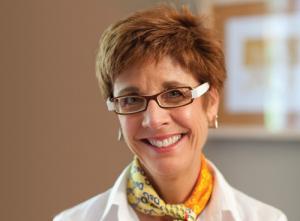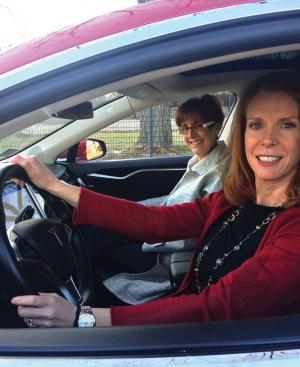We’re Innovating Relentlessly
Lisa Wood is Vice President of Customer Solutions at Edison Electric Institute and Executive Director of the Institute for Electric Innovation.
Becky Knox is Director of Customer Retail Policy at the Edison Electric Institute.
PUF's Steve Mitnick: What are some of the biggest developments around electric vehicles today?

Becky Knox: Battery technology is a big development. It's remarkable how fast the technology is evolving and how fast those costs are coming down. These trends are creating an opportunity to advance EVs much more quickly than a lot of us anticipated.
Another positive development and surprise is the number of announcements that major auto manufacturers made this past fall. Also, there's the mass transit component with electric buses where the market share is exploding. Finally, ride-sharing is increasingly using EVs, and the preferred platform for autonomous vehicles is moving toward electric as well.
These developments are very exciting and the electric power industry is stepping up to provide some support.
PUF: You're saying technology is doing this. Why are batteries becoming so much more cost-effective, and just better in general?
 Becky Knox: Our industry can help put EVs everywhere, to give all consumers access. We can provide access to EVs in disadvantaged communities and in lower-income communities.
Becky Knox: Our industry can help put EVs everywhere, to give all consumers access. We can provide access to EVs in disadvantaged communities and in lower-income communities.
Becky Knox: Batteries are being used in a lot of applications beyond EVs, but battery technology is essential to advance the EV sector. We can see the progress and how it's affected EVs.
In 2007, we had two models of EVs. Now we have multiple EVs offered by twenty-plus different major automakers, from Ford to GM to Volvo and BMW.
Lisa Wood: The cost decline for battery technology is huge for EVs. Batteries are following the path of a new technology.
We've seen that cost decline with wind, we've seen that with solar as well. We're seeing it today with energy storage and battery technology. That's been essential in going from two or three EVs in 2007, as Becky mentioned, to a wide variety of models available today from multiple auto makers.
Becky Knox: Because of the improvement in battery technology, we're seeing longer-range EVs too. EVs such as the LEAF and the Volt started with a range of around thirty to seventy miles. Today's EVs have a two hundred-plus mile range.
Lisa Wood: As the cost declines and the technology improves, we're seeing much more demand for EVs from consumers. The variety of EVs and the longer range are key to meeting consumer needs.
PUF: In past years, there were a couple of moments where it looked like EVs were really going to take over. Didn't happen. But this time, it looks like it is happening. Why is this the time?
Lisa Wood: From my perspective, there are two major drivers, one is carbon. Over the last ten years, the electric power sector has significantly decreased its carbon profile.
Our carbon emissions are now below emissions in the transportation sector and that will continue. The big question today is: how do you reduce carbon in transportation? You electrify! Electric transportation is the path forward.
Another factor is battery cost. There's a big push towards energy storage, and these same batteries are used for EVs. When the costs get to the right point, the market explodes. I think we're finally at that tipping point.
PUF: What's the time frame here? In 2025, 2030, are we going to have a very different fleet?
Lisa Wood: We projected that about three percent of all passenger vehicles on the road will be EVs by 2025, and that's a conservative estimate. That's seven years away. I think the industry will see exponential growth after 2025. It takes a certain amount of time for the existing vehicle stock to turn over. After 2025, most projections show exponential growth.
PUF: But at that point, the percentage of new sales will be a pretty big chunk.
Lisa Wood: Yes, and that percentage keeps growing over time.
PUF: What is the industry doing to get it going to support EVs?
Lisa Wood: There are two important ways the electric power industry is supporting EVs. One is the available EV charging infrastructure. EV charging must be available at home, at work, in public locations, and on highways.
Although most charging is expected to occur at home or at work, public charging is essential, and so is fast charging. Our role, as an industry, is twofold. To help ensure that charging infrastructure is in place where it's needed, and make it seamless and simple for the consumer to use.
Second, to work with the car manufacturers to make this an easy transition for consumers, because those consumers are our customers. In other words, our role is to help to create a level playing field for EVs.
Becky Knox: Another critical role for us is customer education and awareness of the benefits of EVs.
Lisa mentioned seamless and simple charging. You can put infrastructure out there all day, but if it's hard to use, consumers aren't going to use it. As an industry, we need to help create a seamless EV charging experience.
Lisa Wood: That's right. Meaning it must be as simple as going to a gas station and putting in your credit card and seeing the bill.
PUF: Regulatory issues have come up regarding whether utilities should be involved in charging, versus third parties. What are some of the challenges?
Lisa Wood: One challenge is who should be involved in providing charging infrastructure. Our view is that the electric power industry should be involved. We don't have to be the only ones involved, but we do have a track record of helping to jump-start markets.
The electric power industry needs to be engaged in the infrastructure market. What we've seen happen in California, for example, is that regulators change from saying, "Regulated electric utilities cannot be involved," to, "We need you to be involved, because we're not getting the infrastructure that we need."
PUF: There's some forward progress, do you agree? What else is happening on the regulatory front?
Becky Knox: In the last seven to ten years, we've moved from two electric companies with filings, largely in California, to twenty-eight different filings in fourteen states and more companies that are looking to get involved in the EV space.
Many of the EEI member companies are testing a lot of different options to figure out which one is going to work best in their territory. There's no one-size-fits-all approach for infrastructure that's going to work from a national perspective.
We've been working with the regulatory and the consumer advocate communities. Educating them on the benefits of EVs and what an electrified transportation sector means for customers, for the environment, and for the energy grid.
What is the role of the electric utility? At a minimum, we need to ensure that the energy grid infrastructure is in place to support EVs. But we also have a critical role in deploying charging infrastructure, educating consumers, and helping to ensure that charging is a seamless process.
PUF: There are questions about the charging ports going into more expensive neighborhoods. Versus their being universally available, which is more in line with the role of utilities.
Becky Knox: One of the concerns that has been voiced is that "EVs are for rich people."
Our industry can help put EVs everywhere, to give all consumers access. We can provide access to EVs in disadvantaged communities and in lower-income communities. At the end of the day, electricity costs about one dollar a gallon and that's a very good deal for everybody.
PUF: Is there a lot of enthusiasm among the utility companies?
Lisa Wood: Yes. A couple of years ago, EV filings were only in California, Washington, and Oregon. Now, twenty-eight different filings in fourteen states. That's a significant increase.
However, there are regulatory hurdles that we must overcome to be able to provide the infrastructure for these vehicles. As an industry, we need to continue to raise awareness about the benefits of EVs and to educate customers.
PUF: What does that involve?
Becky Knox: We are partnering with Plug In America. They represent the drivers of these vehicles, and others. Together we're working to help get the message out on EVs. We're also working with EEI member companies to better educate our customers about the benefits of EVs.
PUF: How about getting people to do a test drive?
Becky Knox: We did drive events at the last two NARUC annual meetings. We had well over one hundred participants at each one, and most participants were commissioners and staff. A large part of the consumer advocate community participated as well.
Lisa Wood: We just did our own test drive this week in the EEI Tesla.
PUF: Automakers seem to have turned the corner.
Lisa Wood: Yes, we saw several announcements in the fall from Volvo, GM, Ford, and others committing to multiple EV models. Just having automakers say how committed they are to EVs is not something we've seen before. Automakers have their eye on the consumer; they're in the business of selling cars.
These announcements say a lot!
Becky Knox: Good point. That's why we expect to see exponential growth in EVs starting in 2025, where the market just takes off.
PUF: What about pricing for EV charging?
Lisa Wood: We have to address charging prices. This boils down to putting the right prices in place, and at the right times, so that EV charging makes sense for the energy grid and for the consumer.
We have an old name for that: it's called "off peak pricing." All of a sudden EV owners will be saying, "I'm charging at midnight and I want a really low price to do that," or "I want to charge my EV using wind energy at night." The electric utility industry must have the flexibility to meet those customer needs.
PUF: Right, as opposed to the very flat retail rates that we have today for electricity.
Lisa Wood: There's clearly a role for us in getting the pricing right, in deploying charge ports and ensuring a seamless experience for consumers, in making sure the grid is ready for EVs, and in educating consumers and other stakeholders on the benefits of EVs. The electric utility industry's role is to make sure everything works for everybody. And that's what we're going to do. That's what we've always done when it comes to electricity.
PUF 2.0 Articles: We’re Innovating Relentlessly
Prioritizing Efficient Electrification R&D, Convening Stakeholders — By Steve Mitnick, with EPRI SVP Arshad Mansoor
Utilities’ Passion and Hard Work on EV Future — By Steve Mitnick, with EEI’s Lisa Wood and Becky Knox
Rural Power Designing the Future Too — By Steve Mitnick, with NRECA’s Keith Dennis
Future is Now in North Carolina — By NRECA’s Keith Dennis with NCEMC’s Lee Ragsdale and Diane Huis



